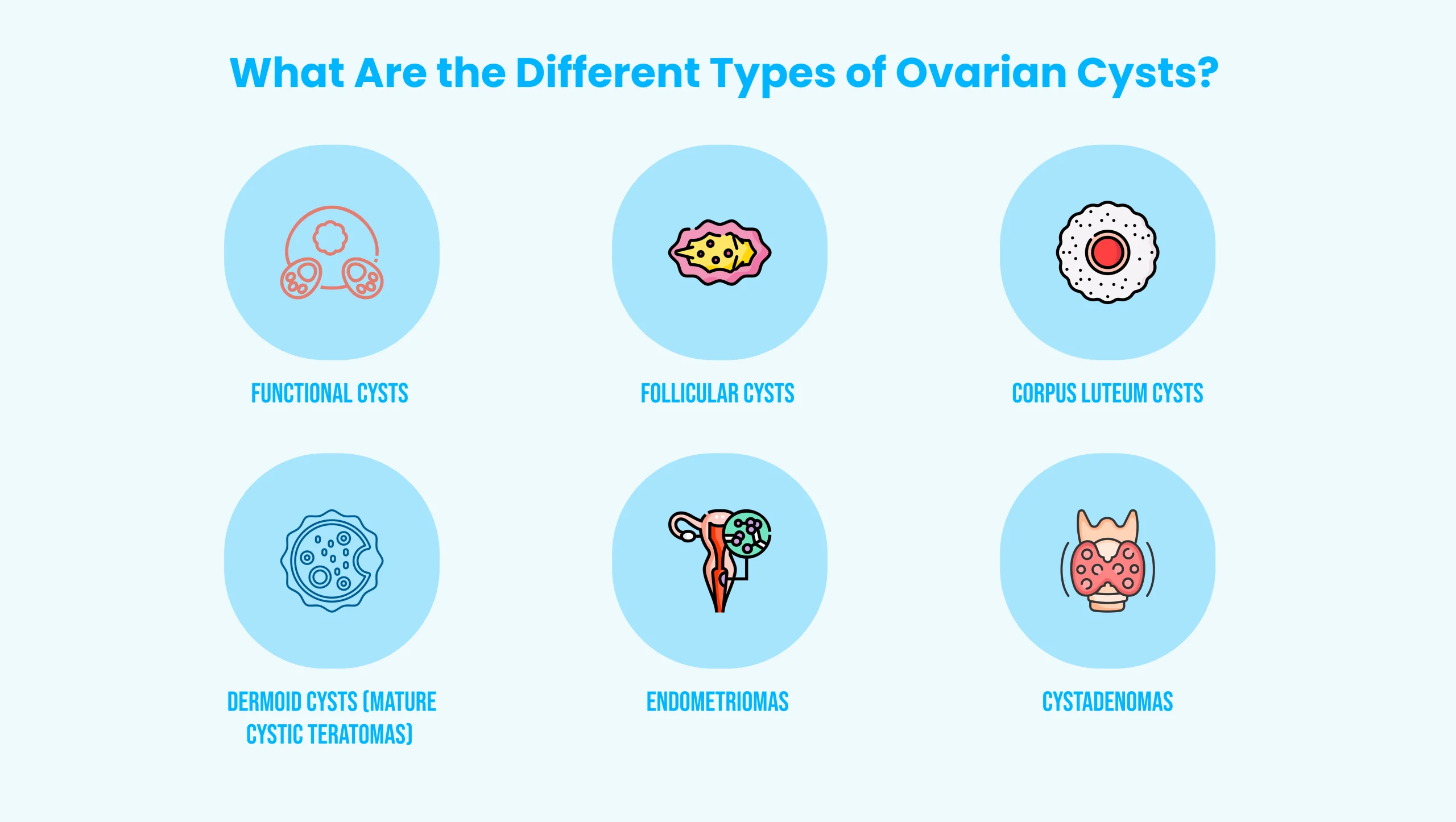Table of Contents

An AIIMS study estimated that one in every four Indian women may develop ovarian cysts. The prevalence of Polycystic Ovary Syndrome (PCOS) also varies across regions, affecting around 4–22% of women.
Ovarian cysts are fairly common among women of reproductive age. In most cases, they are harmless and disappear on their own. However, not all cysts can be ignored, some require treatment or monitoring depending on their size, type, and symptoms. Understanding them helps you make informed decisions about your health.
Recognizing the causes and effects of ovarian cysts in women is essential for making informed health choices and ensuring timely medical evaluation when needed.
Ovarian cysts are fluid-filled sacs that form on or inside a woman’s overies. The majority are functional cysts, which develop during the menstrual cycle and usually resolve within a few weeks.
In some cases, other cyst types can appear due to hormonal changes or underlying conditions such as endometriosis or PCOS. If you’re facing irregular periods or hormonal fluctuations, learning how hormonal imbalances affect women’s health can help you understand the possible causes.
Ovarian cysts are quite common. Studies suggest that one in ten women may develop an ovarian cyst at some point in life. Many go unnoticed, while others can cause bloating or mild discomfort.
If symptoms such as persistent bloating or pelvic discomfort don’t subside, it’s best to visit a women’s health specialist in Chetpet for an ultrasound or further evaluation. Most cysts can be managed through non-invasive treatments and regular follow-ups.

Ovarian cysts vary in type and severity. While many are harmless and fade away naturally, others might require medical observation or minor procedures, such as laparoscopic cyst removal.
| Type of Cyst | Description | Common Symptoms | Treatment Approach |
| Functional Cysts | Develop during the menstrual cycle; usually harmless | Mild abdominal discomfort | Often resolve naturally |
| Follicular Cysts | Occur when the egg isn’t released from the follicle | Bloating, mild pelvic pain | Usually monitored |
| Corpus Luteum Cysts | Form after ovulation when the follicle reseals and fills with fluid | Pelvic pain or pressure | Typically resolve in a few cycles |
| Dermoid Cysts (Mature Cystic Teratomas) | Contain tissues such as skin or hair; non-cancerous but may grow large | Pelvic pain, pressure, or bloating | Removed through laparoscopic ovarian cyst surgery |
| Endometriomas | Result from endometriosis when tissue grows outside the uterus | Heavy periods, discomfort, or fertility issues | May need surgical removal |
| Cystadenomas | Form on the ovary’s surface, filled with fluid or mucus | Abdominal swelling, discomfort | May need removal if large |
Many ovarian cysts do not cause noticeable symptoms. However, larger or more complex cysts can lead to discomfort depending on their size and position.
Typical symptoms include:
Though rare, a ruptured cyst can cause sudden pain or nausea. In such cases, seek immediate medical attention to receive prompt care and relief.
Ovarian cysts are often discovered during routine pelvic exams or ultrasound scans.
Common diagnostic methods include:
Your doctor may recommend follow-up ultrasounds every few weeks to monitor changes.
If cysts are large or persistent, laparoscopic ovarian cyst removal (ovarian cystectomy) may be advised..
Most ovarian cysts are benign, but you should seek medical advice if symptoms persist.
Consult a doctor if you experience:
Avoid home remedies for cyst-related pain if discomfort is severe.
At Dr. Mehta’s Hospitals, noted as one of the best hospitals for menstrual health and reproductive care in Chennai, our gynecology specialists offer comprehensive reproductive and menstrual health services, including ultrasound diagnostics, cyst removal surgery, and minimally invasive treatments.
Ovarian cysts are common and mostly harmless, but timely diagnosis and monitoring ensure the best outcomes. Regular check-ups can help maintain hormonal balance and prevent complications.
If you have concerns about ovarian cysts or fertility issues, visit Dr. Mehta’s Hospitals in Chennai. Our specialists provide personalized, compassionate care to support every woman’s health journey.
Table of Contents
Recent Post
About us
Dr. Mehta’s Hospitals is a leading multispecialty hospital in Chennai with over 90 years of excellence. With 400+ beds and 80+ specialties, its Chetpet and Velappanchavadi centers offer advanced, state-of-the-art, compassionate care under one roof.
Chetpet Contact Details
Velappanchavadi Contact Details
Feel free to ask your queries on
Our Specialities
About us
Dr. Mehta’s Hospitals is a leading multispecialty hospital in Chennai with over 90 years of excellence. With 400+ beds and 80+ specialties, its Chetpet and Velappanchavadi centers offer advanced, state-of-the-art, compassionate care under one roof.
Chetpet Contact Details
Velappanchavadi Contact Details
Feel free to ask your queries on
Our Specialities
Quick Links
Center of excellence